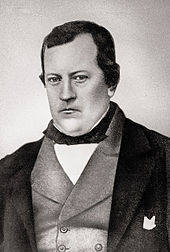Andreas Hamm
Andreas Hamm (born September 9, 1824 in Wittersheim , † June 22, 1894 in Frankenthal (Palatinate) ) was a German bell founder and high-speed press manufacturer.
Live and act
He was born the son of the miller or mill doctor Andreas Hamm (1798-1859) and his wife Maria de la Paix. Like his brother Georg, Andreas Hamm learned the bell foundry from Peter Lindemann in Zweibrücken . Both brothers initially operated their craft in their home town of Wittersheim.
After an apprenticeship and wandering in France, which he left in 1848, his brother Georg called him to support Frankenthal, where he had taken over the long-established Schrader bell foundry in 1844 and, together with the wealthy shipowner Georg Adam Kühnle, also produced gray cast iron . Andreas Hamm settled in the city, married Maria Christmann and set up his own bell foundry and machine factory in 1852. He took over the company shares of his brother Georg, who had to flee due to active participation in the Palatinate uprising and later, after his pardon, settled in Kaiserslautern . Georg Adam Kühnle continued to run the old company on his own, excluding bell production, which later became the Frankenthaler Maschinenfabrik Kühnle, Kopp & Kausch .
In 1856 Andreas Hamm met the technician Andreas Albert , who had been an apprentice at the Würzburg printing machine company Koenig & Bauer . Together they decided in 1861 to manufacture high-speed presses in addition to bells and cast parts, and the Albert & Hamm printing machine factory was founded in 1863 . In 1873, the two business partners separated by mutual agreement and Hamm once again devoted himself mainly to bell casting.
In his company over 1500 larger bells were made; the best known and at the same time largest of these was the imperial bell for Cologne Cathedral in 1874 .
Hamm was a member of the city council and was active as a member of the church administration and co-founder of the church music association in the Catholic parish. He played an important role in Frankenthal's cultural and social life.
Andreas Hamm died on June 22, 1894 in Frankenthal. In 1892 he had already handed over the business to his son Karl Hamm (1866–1931). He, or his son Hermann Hamm (1896–1971), continued the company. The company existed until 1960 when the bell foundry in Frankenthal was closed.
Around 1890 Andreas Hamm and his son Karl started again with the production of presses and printing machines. After the death of the father, the son sold this company division in 1895 to Wilhelm Müller in Heidelberg , from which the global company Heidelberger Druckmaschinen AG (Heideldruck) developed.
A daughter of Andreas Hamm from Frankenthal married her cousin Fritz Hamm, the son of Georg Hamm, in 1875. Fritz Hamm (* 1848 in Kaiserslautern) founded the bell foundry of the same name in Augsburg in 1875, which existed until 1922 under his son Fritz Hamm II (1878–1935).
literature
- Bernhard H. Bonkhoff: Worms and Frankenthal as a bell foundry town , special reprint as a brochure of the Stadtmuseum, from Frankenthal then and now , issue 1 and 2, 1997.
- Bernhard H. Bonkhoff: The bells of the Saarland, Saarbrücken 1997, pp. 63-67.
- Anna Maus: The history of the city of Frankenthal and its suburbs , Pilger-Druckerei Speyer 1969, pp. 118 and 119.
Web links
- Andreas Hamm in the portal of the city of Frankenthal
- Historical bell side with its own chapter on the history of the Hamm company
- Andreas Hamm. frankenthal.de, Frankenthaler Heads area. (PDF document, 56 kB)
- Mill Hamm GmbH
Individual evidence
- ^ Supplement to the "Pfälzer Zeitung" , Ludwigshafen, No. 182, of August 7, 1858; Report on the distribution of the estate after the mother's death in 1858, listing all family members
- ^ Association of German Engineers: "Technology History" , Volume 69, Issues 2-4, 2002, page 165; Excerpt from the source
- ↑ Martin Welke and Boris Fuchs: "Newspaper printing: the development of technology from the 17th to the 20th century" , Volume 58 of "Dortmund Contributions to Newspaper Research " , 2000, page 49, ISBN 3598213212 ; Excerpt from the source
- ^ Karl Walter: "Glockenkunde" , page 753, Pustet Verlag, Regensburg, 1913 excerpts from the source
- ↑ Newspaper article of the Augsburger Allgemeine , of December 24, 2010, on the Fritz Hamm bell foundry
| personal data | |
|---|---|
| SURNAME | Hamm, Andreas |
| BRIEF DESCRIPTION | Bell founders and machine builders |
| DATE OF BIRTH | September 9, 1824 |
| PLACE OF BIRTH | Wittersheim |
| DATE OF DEATH | June 22, 1894 |
| Place of death | Frankenthal |


